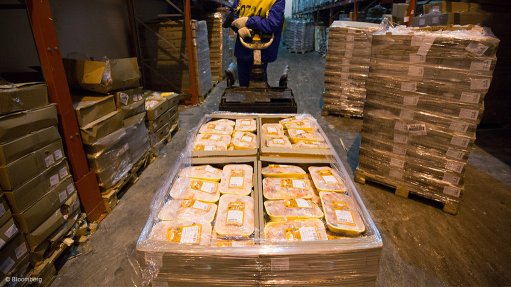
Photo by: Bloomberg
The Department of Trade and Industry (DTI) is on standby to deal with any final technical adjustments the US requires for South Africa to remain a beneficiary of the African Growth and Opportunity Act (Agoa) for the next ten years.
However, Trade and Industry Minister Dr Rob Davies assured that all technical issues and criteria to remain eligible were met and the DTI was now awaiting a response from the US over its proposals to resolve any outstanding issues.
Agoa’s current eligibility criteria required that beneficiary countries eliminated or were working towards eliminating barriers to US trade.
Davies said South Africa and the US were working towards solutions to the remaining unresolved trade issues around poultry, pork and beef.
In an update to the Portfolio Committee on Trade and Industry in Parliament, the Minister indicated that South Africa complied with “all undertakings” to open its market to the US poultry industry by abandoning antidumping duties to a threshold of 65 000 t/y of US chicken imports into South Africa.
However, the quota would only remain in place if South Africa remained a beneficiary of Agoa, a position which hung in the balance after South Africa failed to meet an October 15 deadline to resume imports – without duties – after a ban nearly a year ago owing to fears of the impact of an Avian flu outbreak in the US.
While progress had been made in resolving the long-time poultry impasse, National Chicken Council president Mike Brown earlier stated that it was “not enough” to have reached an agreement in principle in Paris, or to initiate various legal processes in South Africa.
“In our view, South Africa will have only made the progress it is required to make under the Agoa renewal legislation when there are actual imports of US poultry moving into South Africa,” he told a sitting of a US Trade Representative hearing in August into whether South Africa should be suspended from the recently renewed Agoa.
“The ball is in South Africa’s court,” he commented, pointing out that, while the US poultry industry was prepared to support cooperation efforts and ensure the terms and conditions of quota administration were fair and effective, the onus was on South Africa to eliminate the duties, develop quota administration rules and establish conducive sanitary rules.
According to a report by Business Day, the sanitary and phytosanitary issues remained unresolved despite Davies’s assurances.
The initial quota, Brown noted, was just a means to move the Agoa renewal forward and restart trade.
“The quota of 65 000 t/y will represent a smaller share of the South African market [than achieved in previous years] – only about 3.7% of recent domestic consumption, as opposed to the 6.4% share of consumption that our industry had achieved in the 1997 to 1999 period before antidumping duties were imposed,” Brown said.
In 1997, the US industry’s export market to South Africa reached a high of about 62 000 t/y, with an average of around 48 000 t/y achieved between 1997 and 1999.
South Africa had implemented the antidumping duties in 2000 – the same year Agoa was passed into law – effectively shutting US poultry out of its market, despite the US lifting import duties on many goods entering the US from South Africa.
“While US Congress has now conditionally extended Agoa benefits to South Africa, its expectations are clear: South Africa must open its markets to US poultry or lose those benefits. South Africa is on the clock . . . we are watching and so is Congress,” Brown warned at the time.